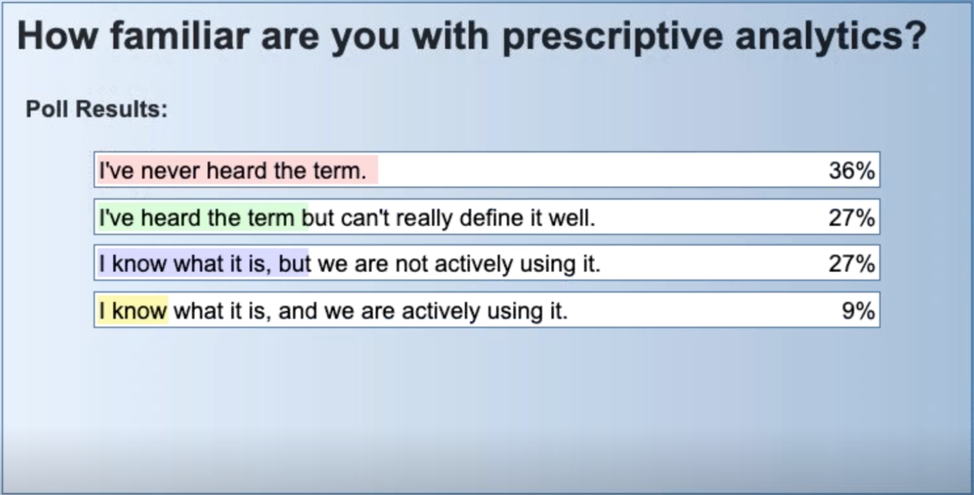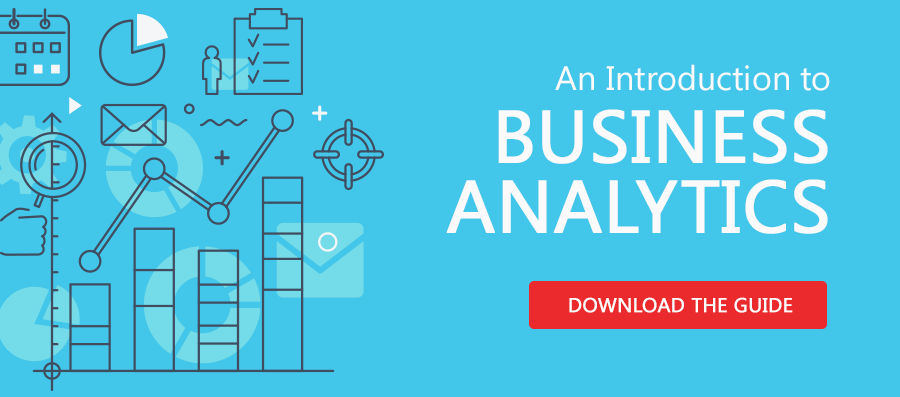Myth #1: Companies believe they already have/use prescriptive analytics.
Just mention advanced analytics or its subsets like machine learning, AI, simulation, etc., and you’ll find many people use these terms interchangeably. Advanced analytics is an umbrella term for the following:
- Predictive analytics – what is most likely to occur
- Prescriptive analytics – what action/s should be taken in order to reach a desired outcome/set of outcomes
Many people get the two terms confused. They hear “prescriptive” and assume “predictive”, when in fact the two are quite different (as noted above).
“When it comes to advanced analytics, people get drawn to the sizzle and overlook the steak,” says Philip Higginbotham, VP Corporate Development at River Logic. He cites an example where one client was focused on having a feature that predicted what a customer would purchase, rather than what products would be most profitable to manufacture.
- The sizzle: Predictive analytics shows what a customer might want.
- The steak: Prescriptive analytics gives the company actionable insights into how to better meet their objectives.
In a recent poll, we found that 36% of people had never even heard of the term “prescriptive analytics.” The same poll showed that 27% had heard the term but could not clearly define it.

So, the next time you think, “Yes, we’re using prescriptive,” check again to be sure.
Myth #2: Companies need to follow an advanced analytics progression path before implementing prescriptive analytics.
Companies need to know the status of their business as well as be able to predict what may happen if certain plans are put into place. However, they don’t need to use predictive analytics before implementing prescriptive analytics solutions.
This myth stems from the marketplace. Many leading analyst firms talk about predictive and prescriptive together, and they often discuss advanced analytics as a progression. However, it doesn’t have to be. Prescriptive techniques take any kind of data available — no predictive is necessary.
Myth #3: Prescriptive analytics is difficult.
Those knowledgeable in mixed-integer linear programming may find it hard to believe that anyone other than data scientists can perform prescriptive analytics. With an estimated one million reported unfilled data science positions in 2018, companies may be holding off until more than 40% of data science tasks are to be automated by 2020.¹
However, prescriptive technologies have come a long way with improved user experiences and a move to the cloud. Computational power also continues to increase, so massive mathematical problems that may have historically taken days to solve can now be unraveled in seconds.
Even linear programming optimization software (a form of prescriptive) oftentimes doesn’t require a data scientist. This has opened up the use of prescriptive analytics to a whole new sector of business users, thus enabling it to bring infinitely more value to the market space.
Myth #4: Prescriptive analytics is heuristics.
It’s true, the market breaks prescriptive analytics into a few categories, one of them being leveraging business heuristics to determine the best path forward. This is the most widely known form of prescriptive analytics because it is seen as a faster, easier form than optimization.
While prescriptive analytics media coverage has been experiencing major growth, the most common use cases are all heuristics- or rules-based approaches to solving problems. The market space is focusing on simple examples, most likely in an attempt to educate business leaders. Unfortunately, this greatly limits leaders from understanding “the art of the possible” with optimization-based prescriptive analytics. As stated earlier, optimization-based approaches have become easier and faster than ever, replacing heuristics-based approaches. Things like capacity planning, CAPEX, value chain planning and so on are leveraging optimization with not only equal speed, but better business results than heuristics approaches.

Myth #5: Prescriptive analytics requires loads of perfect data.
Crap in is crap out. We hear that constantly in the world of analytics. While this is still true for prescriptive, it shouldn’t be a reason to shy away from the idea of leveraging it. Most companies focus on the data they don’t have, and they often wrongly assume they need to first collect certain information that relates to a specific problem before leveraging prescriptive analytics to solve it. However, this is not always the case.
The beauty about prescriptive analytics (and here we’re referring to optimization) is that it helps you understand what data truly is important when solving a specific planning challenge. This is because optimization models demonstrate exactly how parts of the business interact, thus informing what data is necessary. It’s often the case that companies can start by using averages or assumptions and still get phenomenal insights from prescriptive. Companies can then focus on filling the data gaps, thus better informing their decisions and driving even greater ROI.
The point is not to let data concerns block you. More often than not, there is sufficient data and quality to see truly transformational change.
Myth #6: Prescriptive Analytics Requires a Lengthy Implementation
In a matter of weeks to several months, River Logic can model a company’s digital twin to validate the model with the company’s existing financials. Once the pilot phase is successfully completed, complex planning can be generated in a matter of a few days as opposed to plans that would require months to program new what-if scenarios.
Summary
Prescriptive analytics is not limited to industry, function, or type of planning. Its use has shown its versatility for a variety of customers seeking to solve problems, narrow in scope or enterprise-wide.
Mid- to large-companies are learning that advanced analytics is key to competing in the market; it’s no longer a tool for future use, but rather a broad range of solutions to solve today’s most immediate problems in the most profitable way.

¹Gartner Says More Than 40 Percent of Data Science Tasks Will Be Automated by 2020,” Press Release, Gartner, January 16, 2017.



